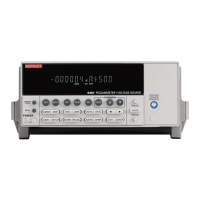D-2 IEEE-488 Bus Overview Model 6487 Reference Manual
Introduction
The IEEE-488 bus is a communication system between two or more electronic devices. A
device can be either an instrument or a computer. When a computer is used on the bus, it
serves as a supervisor of the communication exchange between all the devices and is
known as the controller. Supervision by the controller consists of determining which
device will talk and which device will listen. As a talker, a device will output information;
as a listener, a device will receive information. To simplify the task of keeping track of the
devices, a unique address number is assigned to each.
On the bus, only one device can talk at a time and is addressed to talk by the controller.
The device that is talking is known as the active talker. The devices that need to listen to
the talker are addressed to listen by the controller. Each listener is then referred to as an
active listener. Devices that do not need to listen are instructed to unlisten. The reason for
the unlisten instruction is to optimize the speed of bus information transfer since the task
of listening takes up bus time.
Through the use of control lines, a handshake sequence takes place in the transfer process
of information from a talker to a listener. This handshake sequence helps ensure the credi-
bility of the information transfer. The basic handshake sequence between an active con-
troller (talker) and a listener is as follows:
1. The listener indicates that it is ready to listen.
2. The talker places the byte of data on the bus and indicates that the data is available
to the listener.
3. The listener, aware that the data is available, accepts the data and then indicates
that the data has been accepted.
4. The talker, aware that the data has been accepted, stops sending data and indicates
that data is not being sent.
5. The listener, aware that there is no data on the bus, indicates that it is ready for the
next byte of data.

